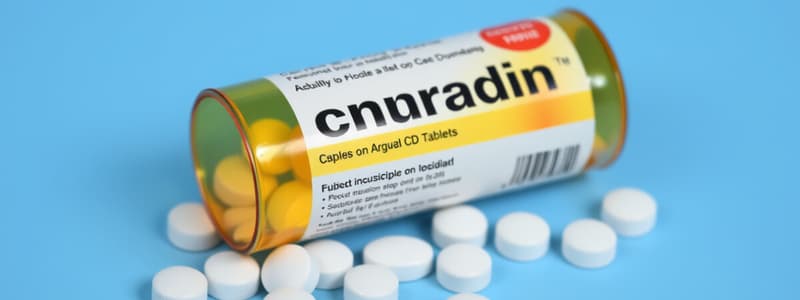Podcast
Questions and Answers
What is the generic name for Coumadin?
What is the generic name for Coumadin?
- Heparin
- Aspirin
- Warfarin (correct)
- Clopidogrel
What classification does Coumadin fall under?
What classification does Coumadin fall under?
- Anticoagulants (correct)
- Antibiotics
- Antidepressants
- Antihypertensives
Which of the following is a side effect of Coumadin?
Which of the following is a side effect of Coumadin?
- Cramps
- Nausea
- Bleeding
- All of the above (correct)
What should be assessed in patients taking Coumadin?
What should be assessed in patients taking Coumadin?
What is the therapeutic blood level range for Coumadin?
What is the therapeutic blood level range for Coumadin?
What is one potential nursing diagnosis for a patient on Coumadin?
What is one potential nursing diagnosis for a patient on Coumadin?
What should be monitored in patients on Coumadin regarding medication interactions?
What should be monitored in patients on Coumadin regarding medication interactions?
It is safe to interchange different brands of Coumadin.
It is safe to interchange different brands of Coumadin.
Vitamin K is the antidote for _____.
Vitamin K is the antidote for _____.
What should be done if a patient on Coumadin misses a dose?
What should be done if a patient on Coumadin misses a dose?
What dietary consideration should patients on Coumadin keep in mind?
What dietary consideration should patients on Coumadin keep in mind?
Flashcards are hidden until you start studying
Study Notes
Coumadin Overview
- Coumadin is the trade name for the generic drug warfarin.
- Classified as an anticoagulant (therapeutic classification) and falls under the coumarins pharmacologic class.
Therapeutic Action and Side Effects
- Common gastrointestinal side effects include cramps and nausea.
- Dermal necrosis can occur as a skin-related side effect.
- Major risk is bleeding, a hematological side effect.
- Miscellaneous side effects may include fever.
Nursing Implications: Assessment
- Monitor patients for signs of bleeding or hemorrhage.
- Evaluate for additional or increased thrombotic events, with symptoms varying by affected area.
- Older patients (over 60) may respond unpredictably to treatment; more vigilant monitoring is necessary.
- Pediatric patients may require more frequent PT/INR testing to maintain therapeutic levels.
- Frequent monitoring of PT and other clotting factors is essential; therapeutic PT ranges from 1.3 to 1.5 times the control.
- PT values equate to INR, with therapeutic INR range generally being 2-3.
- In high-risk embolism patients, target PT of 1.5-2 or INR of 3-4.5 may be aimed for.
- Track hepatic function and complete blood count (CBC) before and during treatment.
- Check stool and urine for occult blood regularly.
Toxicity and Overdose Management
- If PT is excessively prolonged or mild bleeding occurs, withholding one or more doses of Coumadin may suffice.
- For severe overdose scenarios, vitamin K acts as the antidote; whole blood plasma may be needed in extreme cases due to vitamin K's delayed effect.
Nursing Diagnosis
- Potential nursing diagnoses include ineffective tissue perfusion and risk for injury.
Implementation Strategies
- Coumadin is considered a high-alert medication due to the serious consequences of misadministration.
- Verify recent INR or PT results before administration and have a second practitioner review orders.
- Be aware of interactions with a variety of medications, including prescriptions, over-the-counter drugs, and natural products.
- Administer Coumadin at the same time each day for consistency.
- Medication takes 3-5 days to reach effective levels; often initiated concurrently with heparin.
- Avoid brand interchangeability as potencies may not be equivalent.
- Reconstitute with 2.7 ml of sterile water to create a 2mg/ml solution; discard discolored solutions or those with particulate matter.
- Administer via low bolus injection over 1-2 minutes into a peripheral vein.
Patient and Family Education
- Advise on the importance of consistent medication adherence; missed doses should be taken as soon as remembered but never doubled.
- Inform healthcare providers of any missed doses during check-ups.
- Educate on foods rich in vitamin K and advocate for stable, limited intake to prevent fluctuations in PT levels due to vitamin K acting as a warfarin antidote.
Studying That Suits You
Use AI to generate personalized quizzes and flashcards to suit your learning preferences.



